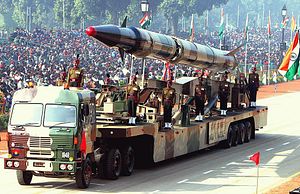A growing consensus among analysts is that India has been undertaking or may have already completed a nuclear posture review whereby India’s nuclear forces are no longer restrained by its “no first use” doctrine. However, there is no explanation from these analysts as to why this posture review is taking place.
This latest wave of scrutiny on Indian nuclear posture has been content with placing the review within the strategic ideology of the current government in New Delhi and has made no attempt to link this to India’s nuclear intelligence and threat assessment. It may be useful, then, to ask whether New Delhi’s strategic establishment is merely conducting an intellectual exercise about nuclear doctrine or is responding to something.
New Delhi is uncertain about the efficacy of its current doctrine, even with all its inbuilt ambiguity regarding first strikes and first use.
First, India is unsure today whether it can continue to be confident in its deterrence of Pakistan. The balance between “deterrence by denial” from Pakistan and “deterrence by punishment” from India appears to have gone past its lease date, at least from the Indian perspective. Inadvertently, New Delhi is testing the limits of Cold War deterrence ideas.
Second, Pakistan may have shifted its nuclear doctrine since the South Asian nuclear tests in 1998, compelling a shift in Indian nuclear doctrine. In that respect the recent escalatory musings from Delhi may indeed be welcomed by Islamabad.
Third, role of China in routinely enhancing Pakistan’s nuclear delivery systems as a way of keeping Indian nuclear doctrine overcommitted to Pakistan and artificially maintaining India-Pakistan nuclear parity has received little attention.
Finally, the role of Indian external intelligence (for example, the Research and Analysis Wing, or RAW) in enabling accurate threat assessments by the National Security Council Secretariat (NSCS), which becomes the basis of the counsel that eventually reaches the Prime Minister’s Office, has received inadequate attention. Alternatively, doctrinal speculations in South Asia can also be read as an outcome of the maturation of nuclear arsenals as both India and Pakistan are moving to a dependable triad capability (although this is less certain in case of Pakistan).
Pakistan appears now to have succeeded in establishing the credibility of its “deterrence by denial” strategy and India’s purported posture review may be striving for “counter-denial deterrence.” A specific intelligence input can only be guessed at this juncture and it may well be that India’s “surgical strike” last fall fueled Pakistan’s forward deployment of its tactical nuclear arsenal.
How precise is the nuclear intelligence available in New Delhi in any case? Evidence suggests a rather high level of sophistication, including knowledge in Delhi of the specific times and dates when Pakistani missiles are moved from their storage locations. For instance, it was known to Indian intelligence that Pakistan had moved M-11 missiles out of their storage sites on the morning of May 28, 1998, the date for Chagai-I tests.
As for China, India has kept track over the years of the precise number of assembled ready-to-use missiles transferred to Pakistan by China but it has been harder to count those being manufactured in Pakistan. For instance, Indian intelligence is routinely aware of the number of missile casings transferred from China to Pakistan for those missiles being manufactured in Pakistan. China had provided casings for Shaheen-I and Shaheen-II. However, recent news that China plans to set up joint missile manufacturing in Pakistan will create further uncertainty regarding this number.
Currently, New Delhi is looking for ways to undermine Pakistan’s deterrence by denial strategy and any suspected Indian posture review would be a concession to the fact that there is reliable information with New Delhi that Pakistan has successfully deployed denial systems. Thus, any Indian strategic rethinking is a likely indication that Pakistan has successfully implemented a credible denial mechanism.
What does this mean for escalation stand-off possibilities between India and Pakistan? First, we must consider how New Delhi looks at Pakistan’s nuclear doctrine. A posture review of “no first use” means that New Delhi is convinced that Pakistani nuclear doctrine incorporates a limited nuclear war concept where Islamabad believes it can contain nuclear damage within the military theater. However, this posture review may have less to do with fortifying New Delhi’s sense of nuclear security than with its intent to increase insecurity for Pakistan nuclear forces.
There is additionally a real probability that India may be actively considering tactical force deployments of its own to implement counter-denial deterrence with Pakistan. As one former national security advisor told this author in the course of an interview for the book The Nation Declassified, “the question of tactical weapons keeps coming on the table but the answer has remained the same.” The implication was that India would not deploy tactical forces at the front end of its nuclear deterrence strategy, but this may be changing today.
A more probable explanation for any looming shifts might be that a posture review will create inconsistencies for Pakistan’s theater-level forces in deciding whether these forces are meant to deter Indian first use or deny a conventional attack. This causal chain goes back to nuclear intelligence available with India’s National Security Council Secretariat, which has a mix of RAW directors, MEA joint secretary-level representatives, military and naval intelligence, et cetera. And finally, there is the lesson of Cold War-era deterrence practice where the principle of deterrence by punishment eventually came to overshadow denial doctrines.
Dr. Vivek Prahladan is Visiting Researcher at Keio University in Japan. Further archival documentation and oral accounts on Indian nuclear history can be found in the author’s book, The Nation Declassified: India and the Cold War World (Har-Anand, India, 2017).

































